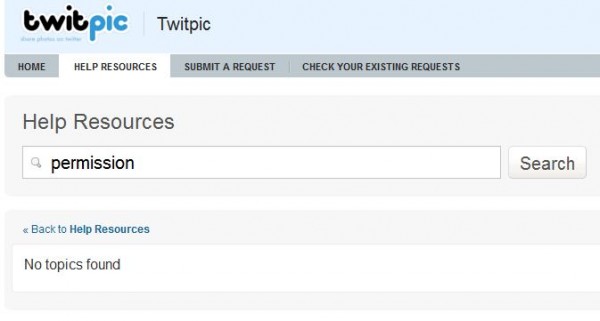News Events, Tweeted Photos & The Permissions Mess
Have you tweeted a great photograph that’s gone viral, such as today’s Space Shuttle launch as seen from a commercial airline flight? Getting credit for that, much less getting paid for it, seems to be a mess. It’s been on my to do list to write about this issue for several weeks. It came up […]
 Have you tweeted a great photograph that’s gone viral, such as today’s Space Shuttle launch as seen from a commercial airline flight? Getting credit for that, much less getting paid for it, seems to be a mess.
Have you tweeted a great photograph that’s gone viral, such as today’s Space Shuttle launch as seen from a commercial airline flight? Getting credit for that, much less getting paid for it, seems to be a mess.
It’s been on my to do list to write about this issue for several weeks. It came up on the Read 2.0 mailing list that I’m part of back in March, about who has the right to grant permission when a photo is tweeted through one of the many sharing services out there.
I may come back and do a more formal look with interviews with the sharing services and Twitter down the line. But given today’s Space Shuttle shot (the awesome picture on the right) and photographer Stefanie Gordon having tweeted about ABC News using it without credit, I thought I’d pull together some of what I posted earlier to the Read 2.0 list and expand a bit.
The Haiti Photos
You might recall hearing about how professional photographer Daniel Morel took pictures from Haiti after the earthquake, tweeted them, then found that AFP (a news wire service) claimed rights to the photos and sold them to others.
What happened, to my understanding, is that after the pictures were tweeted, another person apparently copied them, then AFP copied the copies and put them out on its wire service without permission of either the photographer or the person who copied them. The images, in turn, ended up with Getty for others to license.
The case went to court and still seems to be on going, last I looked. Among other things, AFP seems to have argued when the photographer uploading the photos to the internet via Twitter, various license agreements with Twitter gave the AFP the right to use the images. Twitter, to my understanding, has disagreed with this.
For more about the case, I recommend these two articles:
- Morel Clears First Hurdle in Infringement Lawsuit for Tweeted Photos
- Daniel Morel reacts to World Press Photo wins
Who Has Charlie Sheen’s Permission?
I think most reasonable people would find it kind of insane that the AFP might think it could just take a picture that was posted online and license it out as its own. And yet, I bring you Charlie Sheen:
That’s a rather iconic photo that Sheen put out soon after he started tweeting. It currently has nearly 2 million views. Have I violated any rights by reproducing it above? Who knows?
When the picture first went up, it was arguably news itself, and perhaps fair game to reproduce as an online news event. Certainly plenty of news sites out there used this photo, I recall. I doubt many got explicit permission. Nor do I suspect Sheen’s top priority was getting back to the requests he did receive.
As for the picture itself, there’s nothing that gives guidance about how it can be used. There’s no “don’t use this” or “use with a link back” nor a Creative Commons license. Nothing.
Given that Sheen published this to the world, it’s reasonable to assume he’d want many people to see it. I’d be surprised if he objected to individual news sites putting it on their sites. He might not mind a wire service distributing it. But someone taking it and selling the rights to it? I suspect that Sheen wouldn’t find that to be “winning” at all.
Twitpic Claims The Right?
If you go way down to the bottom of the page, where the picture is hosted at the Twitpic service, there’s an “All Rights Reserved” notice. That’s so far removed from the photo that there’s an argument that Twitpic reserves the rights to the hosting page itself but not necessarily to the photo on it. But what if Twitpic does claim rights to the image?
Actually, it does — some. But Twitpic posted recently to clarify that it wasn’t trying to take ownership of photos. From the Twitpic post:
You the user retain all copyrights to your photos and videos, it’s your content. Our terms state by uploading content to Twitpic you allow us to distribute that content on twitpic.com and our affiliated partners. This is standard among most user-generated content sites (including Twitter). If you delete a photo or video from Twitpic, that content is no longer viewable.
As we’ve grown, Twitpic has been a tool for the spread of breaking news and events. Since then we’ve seen this content being taken without permission and misused. We’ve partnered with organizations to help us combat this and to distribute newsworthy content in the appropriate manner. This has been done to protect your content from organizations who have in the past taken content without permission. As recently as last month, a Twitpic user uploaded newsworthy images of an incident on a plane, and many commercial entities took the image from Twitpic and used it without the user’s permission.
At first glance, this seems reasonable. You keep the rights to your photos. Certainly since that you never have to explicitly sign any terms to use Twitpic or some other sharing services like yFrog, that’s not just reasonable but common sense. Tweeting a picture using a client built into your phone, an app that doesn’t prompt you about rights, shouldn’t cause you to lose any rights.
For example, I signed into yFrog on the web for the first time today, apparently, because it welcomed me and asked me to agree to its terms as part of that. Yet, I’ve shared 557 photos to date through the service never having gone to the site nor having read or agreed to its terms, because various Twitter clients just automatically let me do that.
Despite Twitpic’s statement, there’s plenty that’s not clear. How exactly is Twitpic dealing with requests to use my images, should they come in? And do I get paid? Or is it only a sub-group of people? And is the “distribution” rights that Twitpic has claimed including distribution through services that might charge for my images?
Who knows?
In an article about the recent Twitpic terms change, which got attention on Techmeme, some celebrities will apparently be covered through an agreement between the WENN news network and Twitpic. Which ones? Will the pictures be flagged in some way? Again, it’s all unclear.
How About Some Guidance?
In fact, there’s nothing on Twitpic at all about the correct way to use images or how to deal with permissions. If you hit the help area, there’s no guidance. If you search for permissions information, you get zero answers:
Do a search for “permissions” or “copyright,” and it’s the same situation. Do a similar search at yFrog, and it’s the same. Anyone coming across these photos are left guessing about how to use them, how to contact people or what to do.
At least yFrog allows for picture embedding. In that case, a site can draw the image from the source site and technically not copy it. But this doesn’t help for offline publications. Nor as a user, can I turn this option off, if I want.
You might think that Flickr, a long-established photo sharing site, has a solution with its Creative Commons licensing approach. You’d be wrong.
Flickr’s Big Fail On Creative Common’s Attribution Guidelines is my post from two years ago about how even when a CC license is indicated, it’s still a nightmare to know exactly how to use those images. That’s still the case today, to my knowledge.
What’s really needed is a way for people to easily flag permissions information with their photos. Perhaps by default, all photos can be used online with a link back to the photo hosting site. But maybe people can alter this to allow for other options, such as paid use by news organizations, or to provide contact details or other permissions information.
Lessons From The Hudson Miracle Landing
Remember this image (used below, with permission) of the US Airways jet landing on the Hudson River in January 2009:
Incredible, right? I saw it everywhere, online and in print. I always wondered if the person who snapped it, Janis Krums, earned anything from it.
Krums wrote about what happened with the photo on his blog last year. He doesn’t say if he ever earned anything from the photo, but he does say that major media outlets used it without paying and without permission.
AP didn’t buy the rights but apparently used it, he wrote. CNN and Fox also did the same. But for whatever financial loss he suffered, Krums was pretty relaxed about it, saying:
When I took the photo my priority was rescuing the passengers of the plane and not selling the rights to one of the news organizations.
Even if he wasn’t worried about the passengers, when do you ever see tweeted pictures with copyright statements. No one does this. Heck, there’s not room in the tweets to insert such things.
Krums, by the way, offered Gordon some advice on her picture via Twitter:
@Stefmara Congrats, those are some great shots. Enjoy the twitter fame, it’s a lot of fun! Make sure you copyright the photos. ;-)
Actually, I’m pretty sure under US law (and in many other countries), Gordon already has copyright to the picture. Registering it just gives her more potential damages, should she file a copyright claim.
How Are Permissions Still Such A Mess?
It’s pretty sad that more than a year after making writing his post, this recommendation Krums has for photo sharing services doesn’t seem to have changed:
One thing that I would like to see is the protection of photos in services like TwitPic, YFrog, TweetPhoto, and others. If they implement some type of distribution avenue it could make sense in events of significance. News organization would know where to look for their info and the photographers would be compensated for their material.
Yes, that would be nice. I agree. I’d dearly like to see the picture sharing services get it together to allow those using them better options to indicate how a picture can be licensed or used. Otherwise, rights will just continue to get trampled on.
See Also:
Contributing authors are invited to create content for Search Engine Land and are chosen for their expertise and contribution to the search community. Our contributors work under the oversight of the editorial staff and contributions are checked for quality and relevance to our readers. The opinions they express are their own.
Related stories
New on Search Engine Land


